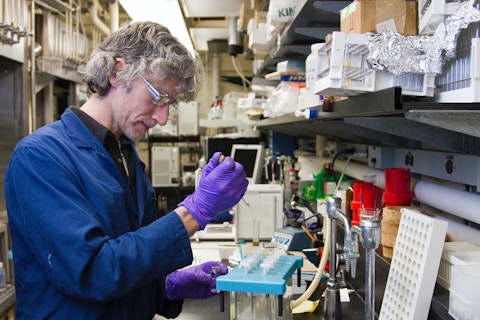In this article, we will be taking a look at the 20 countries with lowest rates of cancer. If you want to skip our analysis of the oncology industry, then head straight to 5 Countries with Lowest Rates of Cancer.
Cancer— a disease in which some of the body’s cells grow uncontrollably and spread to other parts of the body—was the leading cause of death globally in 2020. According to the GLOBOCAN estimates on the global cancer burden produced by the International Agency for Research on Cancer (IARC), around 10.0 million cancer deaths and 19.3 million new cancer cases (excluding nonmelanoma skin cancer) were predicted to have occurred in that year. Female breast cancer was found to be the most commonly diagnosed cancer, with an estimated 2.3 million new cases (11.7%), followed by lung (11.4%), colorectal (10.0 %), prostate (7.3%), and stomach (5.6%) cancers.
In terms of gender, men had a 19% higher incidence rate of all cancers worldwide in 2020 compared to women, though rates varied greatly among regions. Furthermore, half of all instances for both sexes combined occurred in Asia, which is home to 59.5% of the world’s population. In contrast, 23% of all cancer cases were reported from Europe (representing 10% of world’s population), and 21% from North America (equivalent to 5% of the global population).
The aforementioned data indicates that Europeans are particularly hard hit by cancer. So, which country has the highest cancer rate in Europe?
According to the World Cancer Research Fund, Denmark is not only the nation with the highest cancer rate in Europe, but it also holds the top spot globally. The country reported 334.9 cancer cases per 100,000 people, men and women combined, in 2020. With almost 8,115 new cases, gastrointestinal cancer was the most common type of cancer identified in the country.
Don’t Miss: 20 Countries with Highest Rates of Cancer and 20 Countries with the Highest Rates of Skin Cancer.
Oncology Industry: An Analysis
According to a report by Market.Us, the global oncology market (which includes cancer prevention, diagnosis, and treatment), was valued at $208 billion in 2022. The market is anticipated to expand at a compound annual growth rate (CAGR) of 12% from 2022 to 2032, reaching a value of $628 billion at the conclusion of the predicted period. Thriving cancer burden worldwide, growing aging population, increasing disposable income, and availability of advanced products are the key factors influencing the market’s expansion. While Europe held a 24.1% revenue share in 2022, North America’s growing population and rising number of cancer patients led to the region’s dominance in the oncology market. Additionally, the report states that Asia Pacific will grow at the fastest CAGR during 2023-2032.
The key market players in the global oncology market include Merck & Co., Inc. (NYSE:MRK) and Amgen Inc. (NASDAQ:AMGN) among others.
Merck & Co., Inc. (NYSE:MRK), headquartered in Rahway, New Jersey, provides health solutions through its prescription drugs, vaccines, biologic therapies, animal health, and consumer care products. On October 16, the U.S. Food and Drug Administration granted expanded use of its cancer drug Keytruda, also known as pembrolizumab, for the treatment of non-small cell lung cancer (NSCLC). The drug can now be used in combination with chemotherapy as a neoadjuvant treatment given before surgery (to shrink the size of the tumor) and then continued as a single agent as part of an adjuvant treatment given after surgery for treating patients with resectable NSCLC.
On the other hand, the company is popular among several hedge funds. According to Insider Monkey’s second quarter database, a total of 78 hedge funds were bullish on Merck & Co., Inc. (NYSE:MRK). In comparison, 75 hedge funds had invested in the company during the last quarter.
Amgen Inc. (NASDAQ:AMGN), founded in 1980, is an American multinational biopharmaceutical company. The company, which is present in almost 100 countries, focuses on six therapeutic areas: oncology/hematology, cardiovascular disease, inflammation, bone health, nephrology and neuroscience. Some of its medicinal drugs to treat cancer include Vectibix, BLINCYTO, KYPROLIS, and Nplate among others.
Here are some comments made by Amgen Inc. (NASDAQ:AMGN) on its hematology and oncology business during its Q2 2023 Earnings Call:
“Moving to our hematology and oncology business, which includes LUMAKRAS, KYPROLIS, XGEVA, Vectibix, Nplate and BLINCYTO. Strong commercial execution and exciting new clinical data drove 12% volume growth year-over-year for these six innovative products. BLINCYTO sales grew 48% year-over-year with adoption across academic community and pediatric centers. Following positive data from the registration enabling E1910 study presented in December of 2022, an updated NCCN guidelines that were issued in May. Both the positive data and the updated guidelines support our confidence in the continued growth potential for BLINCYTO. Vectibix sales increased 20% year-over-year for the second quarter, driven by 20% volume growth supported by promotion of positive data from the Phase 3 PARADIGM trial demonstrating the superiority of Vectibix over bevacizumab in combination with chemotherapy for patients with wild-type RAS, colorectal cancer.
KYPROLIS grew 9% year-over-year driven by 15% volume growth, partially offset by lower net selling price. And LUMAKRAS reported $77 million of sales for the second quarter. Year-over-year sales were flat in the quarters. 20% volume growth was offset by lower net selling price and inventory levels. We see future growth opportunity for LUMAKRAS driven by launches in new markets and our comprehensive global clinical development program.”
Having said that, let’s now take a look at the countries with lowest rates of cancer.

Photo by National Cancer Institute on Unsplash
Our Methodology
We ranked the countries with lowest rates of cancer based on cancer incidence rates per 100,000 individuals in their populations as of 2020, using data from the World Cancer Research Fund (WCRF), a renowned cancer prevention charity that funds global scientific research into the links between diet, weight, physical activity and cancer.
Countries with Lowest Rates of Cancer
20. Oman
Cancer Incidence Rate Per 100K: 102.1
First up on our list of the countries with the lowest rates of cancer is Oman, situated on the southeastern coast of the Arabian Peninsula. The country reported 3,664 new cases of cancer in 2020. However, through comprehensive cancer prevention programs and high-quality healthcare, the nation is attempting to address its cancer problems.
19. The Democratic Republic of the Congo
Cancer Incidence Rate Per 100K: 101.9
The Democratic Republic of the Congo, also known as Congo-Kinshasa, had 48,337 new instances of cancer in 2020. But, the incidence estimates for this nation are highly questionable since they are not based on a population-based cancer registry.
18. Chad
Cancer Incidence Rate Per 100K: 100.4
Chad, a landlocked country at the crossroads of North and Central Africa, has inadequate access to basic healthcare. The nation’s healthcare spending per capita is about $35, and there are 4.3 doctors and 23.2 nurses for every 100,000 individuals.
In addition, the low frequency of cancer cases in Chad may be explained by the lack of information about the disease and the absence of a department dedicated to its treatment.
17. Sierra Leone
Cancer Incidence Rate Per 100K: 99.8
Sierra Leone, with a cancer incidence rate of 99.8 per 100K individuals, ranks 17th on our list of countries with the lowest rates of cancer.
In this nation, which is among the least developed in the world, breast cancer accounts for the highest burden of cancer among women aged 14–44 years, with cervical cancer following closely behind. An estimated 500 women in the nation receive a cervical cancer diagnosis each year, and 367 of them pass away as a result of the disease. However, because talking about the illness is frowned upon and many cases remain unreported, the true prevalence of the condition is based on estimation.
16. Central African Republic
Cancer Incidence Rate Per 100K: 99.2
As per the most recent WHO data released in 2020, 344 fatalities in the Central African Republic, a landlocked country, were related to breast cancer, accounting for 0.65% of all deaths.
15. Eritrea
Cancer Incidence Rate Per 100K: 98.1
Eritrea, a northeast African country on the Red Sea coast, is among the least developed in the world in 2023, as was previously stated. As such, lack of an efficient cancer registry and local evidence-based research limits the amount of information available on the disease and may be the primary reason for the low incidence of cancer cases in the nation.
14. India
Cancer Incidence Rate Per 100K: 96.4
Cancer rates in India are lower than those seen in Western countries, at 96.4 per 100K people. The low incidence of cancer in the country may be attributed to a number of dietary factors like a comparatively low intake of meat and a predominantly plant-based diet (about 40% of Indians are vegetarians) together with a high consumption of spices like turmeric, which has been shown in multiple studies to have anticancer properties.
13. Saudi Arabia
Cancer Incidence Rate Per 100K: 95.2
Saudi Arabia, situated in West Asia, ranks 13th on our list of countries with the lowest rates of cancer.
The lower prevalence of cancer in the country can be attributed to a number of factors, including genetic predisposition, fasting, eating food prepared with spices like saffron, turmeric, cinnamon, and nutmeg, all of which have antioxidant and anti-cancer properties, and significantly lower rates of alcohol and smoking.
12. Yemen
Cancer Incidence Rate Per 100K: 95.2
The actual incidence of cancer in Yemen, which is at the southern tip of the Arabian Peninsula, is unknown. In addition to the dearth of resources for pathology, epidemiology, and medical records, the main cause of this is that cancer is frequently concealed in the nation.
11. Benin
Cancer Incidence Rate Per 100K: 94.1
Estimated cancer rates in Benin, a country in West Africa, are among the lowest in the world, at 94.1 per 100K people. It is important to keep in mind that this figure does not fairly represent the country’s true cancer incidence because it is one of the world’s poorest countries and lacks the resources required for cancer diagnosis. Additionally, cultural factors contribute to the high number of unreported cases in the nation.
10. Sudan
Cancer Incidence Rate Per 100K: 93.8
Data about cancer in Sudan, one of the least developed nations, is scarce due to an inefficient cancer registry system and lack of properly qualified medical professionals. However, according to GLOBOCAN estimates, non-Hodgkin lymphoma, breast, leukemia, esophageal, and colorectal cancers are the most frequent cancers in both sexes in this Northeast African country.
Moreover, it is one of the least developed nations, and has very few programs for cancer screening, prevention, or early detection.
9. South Sudan
Cancer Incidence Rate Per 100K: 92.8
We previously reported that South Sudan, located in eastern Central Africa, is among the least developed countries in the world in 2023. With a score of 0.39, South Sudan ranked lowest out of 191 nations in the UN Human Development Index in 2021.
South Sudan is one of the countries with the lowest rates of cancer. However, given its lack of properly qualified health professionals and an inefficient cancer registry system, this number does not accurately reflect the country’s actual cancer incidence.
8. Djibouti
Cancer Incidence Rate Per 100K: 88.7
In Djibouti, the rate of cancer deaths for men and women combined was 64.1 per 100,000 in 2020.
This sub-Saharan African nation has one of the lowest rates of cancer, most likely due to the underdiagnosis of the disease there, which is caused in part by the region’s extremely inadequate diagnostic capacity and societal hurdles to seeking medical attention.
7. Timor-Leste
Cancer Incidence Rate Per 100K: 88.6
Lung cancer is the most prevalent cause of cancer-related deaths in Timor-Leste, a country in Southeast Asia, accounting for 14.5% of cancer fatalities in 2020.
Timor-Leste is among the nations with the lowest cancer rates on our list. However, per the WHO, the incidence estimates for this nation are highly questionable since they are not based on a population-based cancer registry.
6. Tajikistan
Cancer Incidence Rate Per 100K: 87.9
Tajikistan’s low cancer rates could be attributed to two factors: moderate smoking prevalence (smokers make up 6.3% of the adult population in the nation) and low rates of alcohol consumption (due to its majority Muslim population, for whom the consumption of alcohol is prohibited and condemned), both of which increase the risk of several cancers.
In 2020, cancer was estimated to be the cause of 3,843 deaths in Tajikistan. Nevertheless, by 2040, the World Health Organization anticipates a sharp rise to 8,012 deaths annually in the country.
Click to continue reading and see the 5 Countries with Lowest Rates of Cancer.
Suggested Articles:
- Top 30 Oncology Companies in the World.
- 25 Best Hospitals for Cancer Treatment in the World
- 14 Best Cancer Stocks To Buy Now
Disclosure: None. 20 Countries with Lowest Rates of Cancer is originally published on Insider Monkey.





